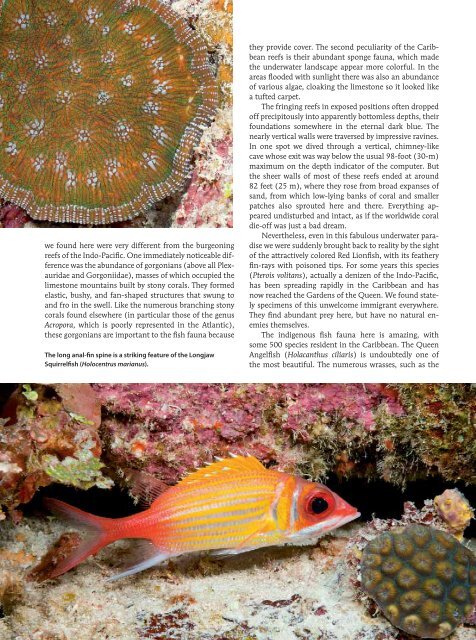Create successful ePaper yourself
Turn your PDF publications into a flip-book with our unique Google optimized e-Paper software.
we found here were very different from the burgeoning<br />
reefs of the Indo-Pacific. One immediately noticeable difference<br />
was the abundance of gorgonians (above all Plexauridae<br />
and Gorgoniidae), masses of which occupied the<br />
limestone mountains built by stony corals. They formed<br />
elastic, bushy, and fan-shaped structures that swung to<br />
and fro in the swell. Like the numerous branching stony<br />
corals found elsewhere (in particular those of the genus<br />
Acropora, which is poorly represented in the Atlantic),<br />
these gorgonians are important to the fish fauna because<br />
The long anal-fin spine is a striking feature of the Longjaw<br />
Squirrelfish (Holocentrus marianus).<br />
they provide cover. The second peculiarity of the Caribbean<br />
reefs is their abundant sponge fauna, which made<br />
the underwater landscape appear more colorful. In the<br />
areas flooded with sunlight there was also an abundance<br />
of various algae, cloaking the limestone so it looked like<br />
a tufted carpet.<br />
The fringing reefs in exposed positions often dropped<br />
off precipitously into apparently bottomless depths, their<br />
foundations somewhere in the eternal dark blue. The<br />
nearly vertical walls were traversed by impressive ravines.<br />
In one spot we dived through a vertical, chimney-like<br />
cave whose exit was way below the usual 98-foot (30-m)<br />
maximum on the depth indicator of the computer. But<br />
the sheer walls of most of these reefs ended at around<br />
82 feet (25 m), where they rose from broad expanses of<br />
sand, from which low-lying banks of coral and smaller<br />
patches also sprouted here and there. Everything appeared<br />
undisturbed and intact, as if the worldwide coral<br />
die-off was just a bad dream.<br />
Nevertheless, even in this fabulous underwater paradise<br />
we were suddenly brought back to reality by the sight<br />
of the attractively colored Red Lionfish, with its feathery<br />
fin-rays with poisoned tips. For some years this species<br />
(Pterois volitans), actually a denizen of the Indo-Pacific,<br />
has been spreading rapidly in the Caribbean and has<br />
now reached the Gardens of the Queen. We found stately<br />
specimens of this unwelcome immigrant everywhere.<br />
They find abundant prey here, but have no natural enemies<br />
themselves.<br />
The indigenous fish fauna here is amazing, with<br />
some 500 species resident in the Caribbean. The Queen<br />
Angelfish (Holacanthus ciliaris) is undoubtedly one of<br />
the most beautiful. The numerous wrasses, such as the<br />
CORAL<br />
97

















